One month ago I sowed most of my Lophophora seed for this season and thought I would post some pictures of the minuscule seedlings, only a couple of weeks old.
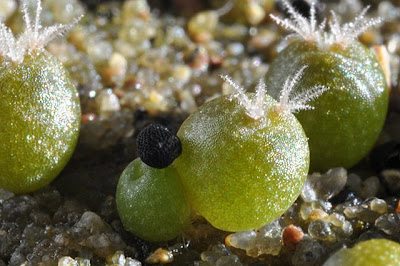
Lophophora williamsii seedlings (VM 534k; El Oso, Coahuila, Mexico)
I again bought seeds originating from the L. williamsii population in El Oso, Coahuila as I'm fascinated with the plants described in the booklet The genus Lophophora – Kaktusy Special 2, 2005 - allegedly this variety forms massive clusters with individual heads measuring up to 15 cm in diameter. The two seedlings in the center front of the above photo have grown from the same seed.
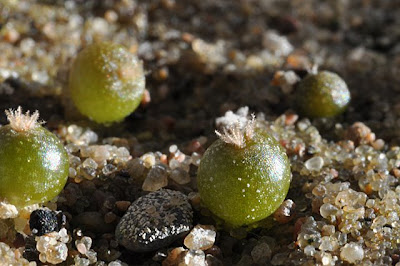
Lophophora decipiens sensu Steven Brack
For a long time I have wanted to grow the Lophophora decipiens offered in the Mesa Garden seed catalog – the plants are alluringly described as “powdery grey”. I have started L. decipiens seeds from Mesa Garden once before but ended up killing off most of the seedlings – to be on the safe side I ordered 100 seeds this time and are going to start them in several, separate batches ;-)
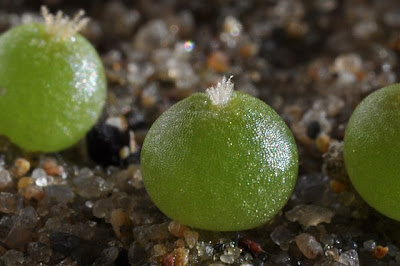
Lophophora fricii seedlings (KS 198; Viesca, Coahuila, Mexico)
I'm growing increasingly enchanted with Lophophora fricii but don't really have any mature specimens of this interesting species (except one plant that is almost of flowering size). To amend this I'm starting batches of Lophophora fricii from seed on a regular basis.
.jpg)
Lophophora williamsii seedlings (SB 418; Presidio County, Texas)
The L. williamsii plants from Presidio County, Texas represent the northernmost form of L. williamsii, also known as Lophophora williamsii var. echinata, and is a self-evident candidate for growing in the coldhouse.
Tuesday, May 12, 2009
Lophophora seedling pictures
Monday, February 02, 2009
Flowering Lophophora decipiens

Flowering Lophophora decipiens
In 2005 I sowed my first Lophophora decipiens seeds bought from Pavel Pavlicek. The plants grow in my coldhouse and flowered for the first time in the summer of 2008 where these pictures were taken.
Flowering Lophophora decipiens viewed from above
I'm not quite sure what to make of the long, flimsy, pink petals, and the plants are still too young to tell what the adult body morphology will look like so for now I can only say that the plants live up to their name (decipiens meaning “deceiving” ;-)
Leon Croizat's description of Lophophora williamsii var. decipiens stated that the vegetative body of this variety was basally tubercled or with distinct podaria rather than ribs, and that the flower extended out of the top of the plant to a greater extent. This description was based entirely on an illustration in Britton and Rose, The Cactaceae volume 3, plate 10, figure 4 (see below). Some researchers, e.g. Anderson, have argued that these characters are not consistent enough in occurrence to justify separate taxonomic status while others, including Gerhard Köhres, state that plants corresponding to Croizat's description grow near El Amparo in the state of Coahuila, Mexico and should be counted to the Lophophora fricii complex.
The Cactaceae, Volume III, Plate X
I have recently bought some Lophophora decipiens seeds from Steve Brack and look forward to see how they develops.
Sunday, March 30, 2008
Lophophora - experiments in cold hardiness, 2008
As mentioned in the previous post on Ariocarpus and Epithelantha I have experimented with coldhouse grown Lophophora since 2004.
Lophophora williamsii (SB 854; Starr Co, Texas), 2004
The Lophophora williamsii (SB 854; Starr Co, Texas) plants from the 2004 batch are still doing great. The plants are growing true to the type with a glaucous bluish-green epidermis. The one on the left flowered last year so I'll soon be able to produce seeds originating from plants that have survived several seasons in an unheated greenhouse. During winter all my Lophophora plants are wrapped in horticultural fleece - both as a protection against the cold but also to keep out hungry pests.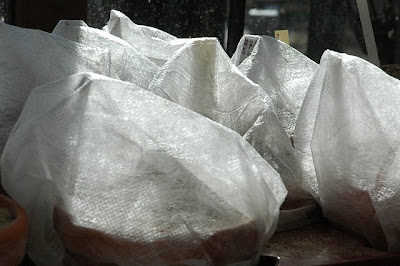
Lophophora plants wrapped in horticultural fleece
Some of the plants needed to be repotted before the upcoming growing season, for example these Lophophora williamsii (SB 854; Starr Co, Texas) plants from the 2005 batch.
Lophophora williamsii (SB 854; Starr Co, Texas), 2005
The plants started from seed in 2005 have grown to 2.5 - 3 cm (~ 1'') in diameter - with a bit of luck they might flower already this summer.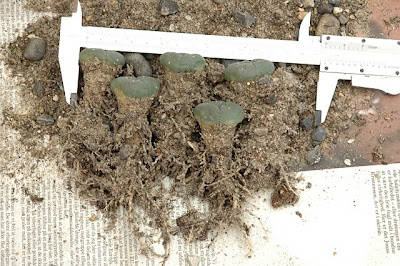
Uprooted Lophophora williamsii (SB 854; Starr Co, Texas), 2005
I never cease to be marveled by how large a fraction of a Lophophora plant that is actually growing underground. The plant pictured below has a crown that is approximately 1 cm high while the massive part of the taproot amounts to 4 times that and the full root system is more than 10 cm long.
Lophophora williamsii (SB 854; Starr Co, Texas) with exposed root, 2005
The past winter was mild - the coldest temperature registered inside the coldhouse was -5C (23F) - so even my Lophophora diffusa and Lophophora decipiens plants have all survived without any signs of damage. 
Lophophora diffusa (Higuerillas, Queretaro, Mexico)
The Lophophora decipiens plants are very shriveled and look in dire need of a drink of water. They'll have to wait for a couple of more weeks in order for the weather to warm up.
Shriveled Lophophora decipiens
Last year I grafted a handful of Lophophora williamsii (SB 854; Starr Co, Texas) seedlings on frost hardy Opuntia compressa (Monmouth County, New Jersey) stock. The grafts seem to be doing well and I'll get back with more information on Opuntia grafting when I've done some more experiments.
Lophophora williamsii (SB 854; Starr Co, Texas) grafted on Opuntia compressa stock
Saturday, March 31, 2007
Lophophora and Epithelantha - experiments in cold hardiness II
Since 2004 I’ve experimented with growing Lophophora, Epithelantha, and Acharagma in an unheated greenhouse in Denmark. The winter this year has been damp but not very cold - the coldest temperature registered in the coldhouse was -5C (23F) – so even the L. diffusa plants are doing great. 
Lophophora williamsii (SB 854; Starr Co, Texas)
The L. williamsii plants (sown May 2004) are thriving in the coldhouse. The epidermis is glaucous bluish-green, much truer to the type than plants grown in my windowsill. All my cold grown Lophs are wrapped in horticultural fleece during winter – not so much because of the temperature, but to avoid attacks from various critters. This kind of damage is not a problem with the spine covered species.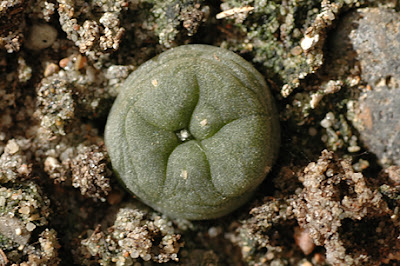
Lophophora diffusa (Higuerillas, Queretaro, Mexico)
In 2005 I sowed L. diffusa and L. decipiens to grow in the coldhouse. Especially the L. diffusa plants had a hard time last winter and only 2 survived. Both are now doing fine and are developing the typical yellowish-green epidermis. 
Lophophora decipiens
L. decipiens is not a “good” species; it’s probably just a cultivar form of Lophophora fricii (I couldn’t obtain any collection data for these seeds either when I bought them). Anyway, the plants are doing well and are getting ready to go 8-ribbed at an age of two.
I’m growing both “regular” Epithelantha micromeres and Epithelantha micromeris v. gregii. The gregii variety seems to be a faster grower than the regular micromeres; it also has a very beautiful coverage of spines, as illustrated below.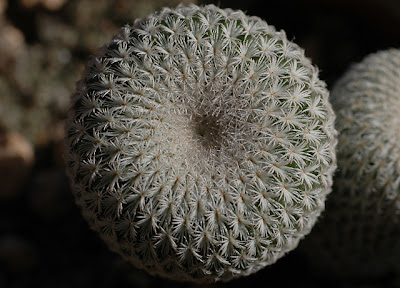
Epithelantha micromeris v. greggii (Cuesta la Muralla, Coahuila, Mexico)
Epithelantha micromeris v. greggii – closeup
All of the Epithelantha plants made it through this winter without damage.
Saturday, May 14, 2005
Sowing in the rough
If I don’t chicken out, the plants growing from the seeds sown today are going to spend the rest of their lives in an unheated greenhouse in Denmark. 30 seeds of each of the below species were sown.
- Acharagma aguirreana (RSM 396; Sierra Paila, Coahuila)
- Acharagma roseana (LX 578; Ramon Arizpe, Coahuila)
- Lophophora williamsii v.decipiens
- Lophophora williamsii (RS 268; Huizache, San Luis Potosí)
I also sowed some leftovers from last year. 10 seeds each of:
- Lophophora diffusa (JR; Higuerillas, Queretaro)
- Lophophora williamsii (SB 854; Starr Co, Texas)
A cold house batch of the two latter species was also sowed last spring. Most plants survived the winter and are now resuming growth.
| next >
All Time Most Popular Posts
-
Lophophora williamsii (peyote) populations have diminished in large areas of South Texas where peyoteros harvest the cactus for ceremonial ...
-
On various occasions I've been asked what growing media I'm using for my cactus plants. I don't have a set soil mix recipe as su...
-
Below is a list of retailers/nurseries selling cactus seed and plants. I've only listed vendors I've done business with. If you ar...
-
Most cacti are easily grown from seed - and with a little patience and care they can be grown into beautiful plants. Lophophora williamsi...
-
In last month’s post on the troubled Texan peyoteros I referred to Anderson’s article on the peyote situation in Texas. Given the importanc...
-
Yet another slightly off topic and probably not entirely politically correct post, but I couldn’t help noticing the similarity of my monstr...
-
Flowering stand of San Pedro cacti (Trichocereus pachanoi) To me the main draw of the San Pedro cactus ( Trichocereus pachanoi (syn. Ech...
-
In the June 2008 issue of the Cactus & Co magazine Jaroslav Šnicer, Jaroslav Bohata, and Vojtěch Myšák described a new Lophophora spec...
-
There seems to be an increased focus on the alarming Texas peyote situation. A couple of weeks ago the Houston Press published a mournful, i...
-
I spent two weeks working in Delhi, India during January. I had one weekend off and had planned to spend it in Delhi at my own leisure, but ...


















